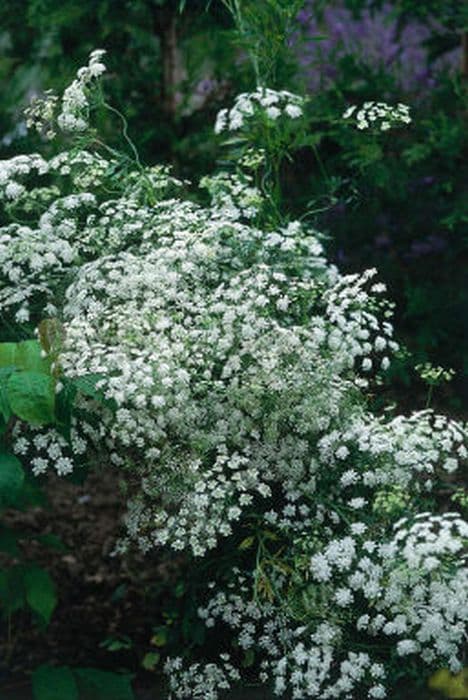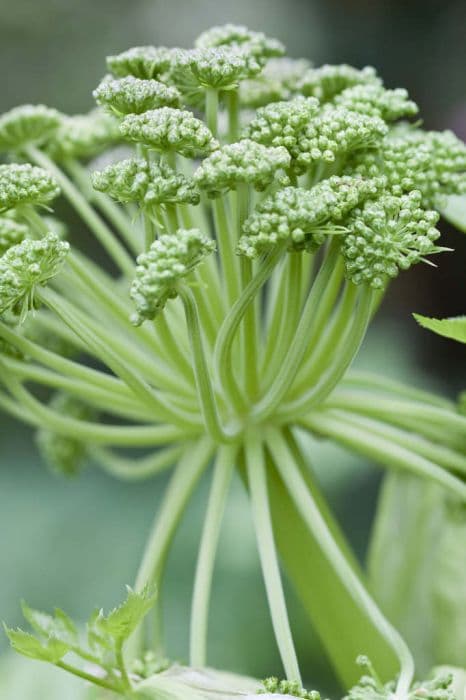Great Masterwort Astrantia major 'Ruby Wedding'

ABOUT
The Astrantia major 'Ruby Wedding', commonly known as Great Masterwort, is a charming perennial plant that boasts a striking appearance. It is characterized by pincushion-like flowers that present a deep ruby red hue, and these blooms possess a distinctive, intricate look. Each flower comprises tiny, tightly-packed florets that are surrounded by a starry collar of bracts, which may sometimes have a paler or greenish tinge contrasting beautifully with the darker tones of the flowers. The foliage of the Great Masterwort adds to the plant's aesthetic appeal, with leaves that are deeply lobed and feature pointed tips. These leaves exhibit a lush green color that provides a lovely backdrop to the richly colored flowers. The overall structure of the plant presents an upright and clumping form, with the striking flowers held aloft by wiry stems that rise above the foliage, giving a delicate and airy appearance to the plant. Great Masterwort blooms in the summer months, offering a long-lasting floral display that can extend into early fall with the right conditions. Additionally, the intricate beauty of the flowers makes them a favorite for fresh floral arrangements and they are also known to attract pollinators such as bees and butterflies to the garden. The appealing combination of the romantic deep red flowers and attractive green leaves makes the Astrantia major 'Ruby Wedding' a sought-after plant for gardeners looking to add a touch of drama and elegance to their garden spaces.
About this plant
 Names
NamesFamily
Apiaceae.
Synonyms
Great Masterwort, Hattie's Pincushion, Melancholy Gentleman.
Common names
Astrantia major 'Ruby Wedding'.
 Characteristics
CharacteristicsLife cycle
Perennials
Foliage type
Deciduous
Color of leaves
Green
Flower color
Dark red
Height
2 feet (60 cm)
Spread
1.5 feet (45 cm)
Plant type
Herb
Hardiness zones
5
Native area
Europe
Benefits
 General Benefits
General Benefits- Attracts pollinators: Providing a food source for bees and butterflies due to its nectar-rich flowers.
- Low maintenance: Once established, Astrantia major 'Ruby Wedding' requires minimal care, making it ideal for busy gardeners.
- Drought tolerance: It has the ability to withstand periods of dry weather, which is beneficial for water conservation.
- Long blooming period: It offers a lengthy display of flowers, often from early summer into the fall.
- Aesthetic appeal: The deep ruby red flowers add a striking visual component to garden spaces.
- Shade tolerance: Capable of growing in partially shaded areas, which can sometimes be challenging for gardeners.
- Cottage garden favorite: Fits well into traditional cottage garden schemes with its old-fashioned charm.
- Cut flower: The blossoms hold up well in bouquets, making them a great choice for home-cut floral arrangements.
- Rabbit resistance: Generally not favored by rabbits, which can help to reduce garden damage by wildlife.
- Deer resistance: Also not preferred by deer, protecting it from being eaten in areas with high deer populations.
- Border plant: Ideal for use in perennial borders due to its size and showy flowers.
- Companion planting: Works well when planted with other perennials, creating a diverse and attractive garden landscape.
 Medical Properties
Medical PropertiesThis plant is not used for medical purposes.
 Air-purifying Qualities
Air-purifying QualitiesThis plant is not specifically known for air purifying qualities.
 Other Uses
Other Uses- Astrantia major 'Ruby Wedding', commonly known as Great Masterwort, can be used in dried flower arrangements due to its persistence and shape, retaining its form and color well after drying.
- The resilient seed heads of Great Masterwort are sometimes used in crafts or as a natural decoration in wreaths and potpourri.
- Great Masterwort's distinctive, pincushion-like blooms can serve as an intriguing subject for botanical illustration and photography, due to their unique structure and rich color.
- The plant can be employed in educational gardens or biology classes to teach about plant structure, pollination, and the variety of flower forms in the plant kingdom.
- As a perennial with interesting textures, Great Masterwort adds a tactile element to sensory gardens designed for therapeutic or educational purposes.
- Its blooms are sometimes utilized as a natural dye for fabrics, yielding subtle colors that can be used in artisanal textile projects.
- Great Masterwort can also be included in a rain garden, where its tolerance for moist soil conditions helps manage water runoff in a sustainable way.
- The dense clumps formed by Astrantia major 'Ruby Wedding' can act as a living mulch, suppressing weeds and maintaining soil moisture in garden beds.
- In floral language and symbolism, Great Masterwort blooms can represent courage and strength, making them suitable for thematic gardens or as part of a symbolic gift bouquet.
- In a cottage garden setting, Great Masterwort contributes to the biodiversity by attracting beneficial insects such as bees and butterflies, which are essential pollinators for many plants.
Interesting Facts
 Feng Shui
Feng ShuiGreat Masterwort is not used in Feng Shui practice.
 Zodiac Sign Compitability
Zodiac Sign CompitabilityGreat Masterwort is not used in astrology practice.
 Plant Symbolism
Plant Symbolism- Protection: Astrantia major, commonly known as Great Masterwort, has been historically used in folk medicine and believed to ward off evil spirits, symbolizing protection.
- Unity: The intricate star-like shape of Great Masterwort’s flowers represents the coming together of many parts into a whole, symbolizing unity and togetherness.
- Perseverance: Great Masterwort thrives in various conditions and has a resilient nature, making it a symbol of perseverance and endurance.
- Mystery: With its dark, ruby-hued flowers, the 'Ruby Wedding' variety adds an element of depth and enigma, representing mystery and complexity.
- Celebration: The 'Ruby Wedding' cultivar, by its very name, suggests celebration, particularly of a 40th anniversary, symbolizing lasting love and commitment.
 Water
WaterGreat Masterwort prefers consistently moist soil, so regular watering is essential. It should be watered deeply once or twice a week, depending on weather conditions, allowing the soil to remain damp but not soggy. During hotter and drier periods, increase the frequency to maintain moisture since it does not tolerate drought well. Each watering session should provide enough water to soak the roots, which would equate to approximately 1 to 1.5 gallons of water for an established plant in a garden setting. Always check the soil moisture level before watering to ensure it is necessary, as overwatering can be just as harmful as under-watering.
 Light
LightGreat Masterwort thrives in partial shade to full sun, with a preference for a spot that receives morning sunlight and afternoon shade to protect it from the intense heat of the day. Ideal lighting conditions are bright but indirect light, which will encourage vibrant growth without scorching the delicate leaves and flowers. This plant is versatile enough to do well in varying light conditions, but too much direct, hot sunlight can lead to leaf burn.
 Temperature
TemperatureGreat Masterwort is hardy in a range of temperatures and can survive minimum temperatures down to about 0 degrees Fahrenheit, making it suitable for many temperate climates. It is most content in temperatures ranging from 60 to 75 degrees Fahrenheit. However, it can withstand summer temperatures up to the mid-80s if provided with enough moisture and shade during the hottest part of the day.
 Pruning
PruningGreat Masterwort benefits from pruning to remove faded flowers and encourage repeat blooming throughout the summer. Prune the spent blooms regularly, cutting back to the base of the flowering stem. Additionally, cut back the foliage in late fall or early spring to tidy up the plant and stimulate new growth. The best time for a more thorough pruning is after the main flowering period has finished in late summer or early fall, to maintain shape and overall health of the plant.
 Cleaning
CleaningAs needed
 Soil
SoilGreat Masterwort 'Ruby Wedding' prefers a rich, moist, well-draining soil with a pH range of 5.5 to 7.5. A balanced mix of garden soil, compost, and a bit of sand or perlite would do well.
 Repotting
RepottingGreat Masterwort 'Ruby Wedding' does not need frequent repotting and can be done every 2-3 years or when the plant outgrows its current pot.
 Humidity & Misting
Humidity & MistingGreat Masterwort 'Ruby Wedding' tolerates average garden humidity levels but thrives in higher humidity, without the need for tropical conditions.
 Suitable locations
Suitable locationsIndoor
Provide bright light and keep soil moist for Great Masterwort.
Outdoor
Plant in partial shade, keep soil moist, and mulch around Great Masterwort.
Hardiness zone
4-7 USDA
 Life cycle
Life cycleAstrantia major 'Ruby Wedding', commonly known as Masterwort, begins its life cycle as a seed, which when sown, germinates to produce a small seedling. As the plant grows, it develops a rosette of lobed, basal leaves from which a sturdy stem emerges. In late spring to early summer, the Masterwort blooms, showing off its distinctive pincushion-like, ruby-red flowers surrounded by a ruff of bracts. After pollination, often by insects attracted to the flowers, it sets seed which ripens through the summer. In autumn, the above-ground parts of the plant die back to the ground, with the plant surviving the winter in a dormant state as a rootstock. In the following spring, Masterwort re-emerges from the rootstock, beginning the cycle anew.
 Propogation
PropogationPropogation time
Early Spring to Summer
Propogation: The Astrantia major 'Ruby Wedding', commonly known as Masterwort, is often propagated through division. The best time to carry out division is in either early spring or autumn when the plant is not in active growth. To propagate by division, carefully dig up the plant and gently separate the clump into smaller sections. Each section should have a portion of root and several shoots. Replant these divisions at the same depth they were originally growing and water well to establish them. It's important to ensure the divisions have plenty of moisture and are not subjected to drought during their first growing season after propagation. This method of propagation helps to create a larger display of the plant's beautiful, deep ruby-red flowers and textured foliage more quickly than seed propagation would.









